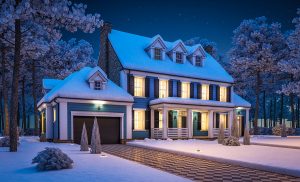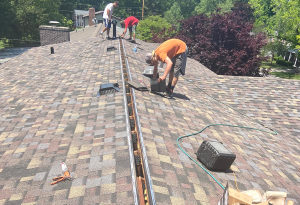When building a new house or rehabbing an older one, choosing the right types of roofs can be harder than you realize.
Roofs do a lot more than just serving the most basic practical purpose of protecting a house and its occupants from the outside elements. For instance, a roof’s shape plays a major role in defining the overall look and style of a house. A roof can also provide additional living space, as well as make your home more resilient, energy-efficient, and weatherproof.
This guide to the types of roofs will help you understand and identify the best roof shape for your home.
Gable Roofs
Also known as a pitched or peaked roof, gable roofs are some of the most types of roofs out there. They are easy to recognize by their triangular shape.
Pros:
Gable roofs will easily shed water and snow, provide more space for the attic or vaulted ceilings, and allow more ventilation. Their simple design makes it easy to build them and cheaper than more complex designs.
Cons:
Gable roofs can be problematic in high wind and hurricane areas. If the frames are not properly constructed with adequate supports, the roof can collapse.
High winds can also cause materials to peel away from gable roofs. If there is too much of an overhang, winds can create an uplift underneath and cause the roof to detach from the walls.
If you use a gable roof in high wind areas, be sure you use proper braces and have the roof inspected after a large storm to ensure no damage has occurred.
Types of Gable Roofs
Side Gable: A side gable is a basic pitched roof. It has two equal panels pitched at an angle and meets at a ridge in the middle of a building. The triangle section can be left open for an open gable roof, or enclosed for a boxed gable roof.
Crossed Gable: A crossed gable roof is two gable roof sections put together at a right angle. The two ridges are perpendicular to each other. Lengths, pitches, or heights may or may not differ from each other.
Hip Roofs
A hip roof has slopes on all four sides. The sides are all equal in length and come together at the top to form a ridge.
Pros:
Hip roofs are more stable than gable roofs. The inward slope of all four sides makes it sturdier and more durable. They are excellent for both high wind and snowy areas. The slant of the roof allows snow to easily slide off with no standing water.
Hip roofs can also offer extra living space with an addition of a dormer!
Cons:
Hip roofs are more expensive to build than gable roofs. This is because it is a more complex design that requires more building materials. Also, with the addition of a dormer, additional seams can make it easier for water leaks to form in the valleys if someone did not properly install the roofing system. Proper construction and maintenance are a must to prevent minor issues from turning into major problems.
Types of Hip Roofs
Simple Hip: The most common type of hip roof. It has a polygon on two sides and a triangle on two sides. The sides come together at the top to form a simple ridge.
Cross Hipped: Similar to a cross gable roof. Use separate hip roofs on homes with different wings. The line where the two roofs meet is called a valley. Valleys can allow water to pool. Proper waterproofing is a must for this type of hip roof.
Half Hipped: A standard hip roof that has two sides shortened to create eaves.
Mansard Roofs
A mansard roof, also known as a French roof, is a four-sided roof with a double slope on each side that meets, forming a low-pitched roof. The lower slope is much steeper than the upper. The sides can either be flat or curved, depending on the style.
Pros:
Mansard roofs can help provide a great deal of extra living space. Using the space as a full attic or living quarters, called a garret, is very popular. The style lends itself to either open or closed dormers for more aesthetic appeal.
Mansard roofs are great for people wanting the flexibility to make future home additions. When first designing and building a home, you can actually save money by having a simple mansard design to start off. You can then add on a garret or dormers later. This will not only add value to the house, but also allows homeowners to easily make additions as their needs change.
Cons:
A low-pitched portion of a mansard roof isn’t ideal for areas receiving heavy snowfall.
Mansard roofs cost more than typical roofs because of the embellishments and details that go into them. However, the added space and character can more than make up for the extra cost of the initial construction.
Types of Mansard Roofs
Mansard roofs can take various silhouettes, including straight-angle, convex or concave. Windows are very important to provide light for the extra living space provided.
Gambrel Roofs
A Gambrel roof on a two-story house covered with cedar shingles on the lower part or side of the gambrel as siding, and asphalt shingles over the upper spans of the Gambrel roof
A Gambrel roof is much like a mansard in the sense that it has two different slopes. The difference between the two is that the Gambrel only has two sides, while the mansard has four.
Similar to mansard, the lower side of the Gambrel roof has an almost vertical, steep slope, while the upper slope is much lower. We typically see Gambrels on top of barns, farmhouses, and log cabins. They are also seen on Dutch Colonial and Georgian-style homes, as well.
Pros:
Much like the mansard, the Gambrel provides extra living space for a garret, attic, or loft. Plus, it’s simple to frame out. The Gambrel only uses two roof beams, along with gusset joints. Since the construction is quite simple with fewer materials needed, this helps to keep the cost of a roof down.
Gambrel roofs are also a great idea for outdoor sheds and storage buildings. Their shape can provide more storage without taking up more space.
Cons:
We do not recommend the Gambrel roof for heavy wind areas or regions that receive significant snowfall. The open design can cause the roof to collapse under extreme pressure.
Gambrel roofs also need to be constructed well, waterproofed at the ridges, and maintained regularly. It’s a good idea to have a Gambrel roof inspected each year to check for damage from storms, heavy rainfall, or snow.
We recommend windows for a Gambrel roof to add light to the extra space. This is both a pro and a con. While all details will add to the overall beauty of a home, they increase the chances for water leaks to occur.
Flat Roofs
Flat roofs appear to be completely flat with no pitch. However, they do have a slight pitch to allow for water run-off and drainage. We used these roofs in industrial or commercial buildings. However, they can also be installed on residential houses in both high and low rainfall areas.
Pros:
Extra living space on the roof for a patio or garden. They can also place heating and cooling units on flat roofs, keeping them out of sight. The design is also conducive to installing solar panels for a more energy-efficient and energy-independent home. Flat roofs are easier to construct than pitched roofs and require fewer building materials, keeping costs down.
Cons:
The low pitch makes flat roofs more susceptible to water leakage. We do not advise them for high rainfall or high snowfall areas.
Although the upfront cost of building a flat roof is less expensive than a pitched roof, however, flat roofs can sometimes be more expensive in the long run because of maintenance and ongoing roof repairs and replacement costs.
Final Thoughts
These aren’t the only types of roofs available, just the only ones we had the space to write about today. Look out for Part 2 (and possibly Part 3!) on types of roofs soon! If you are ready for your own roofing transformation, don’t hesitate to give us a call today at 636-699-0449.





